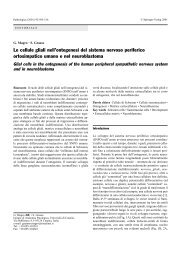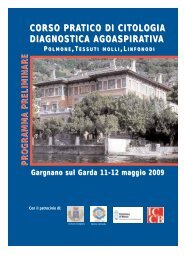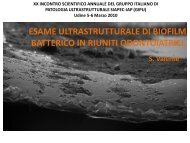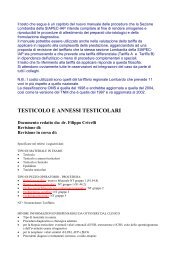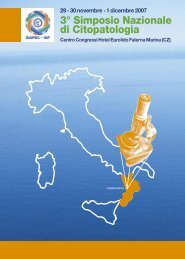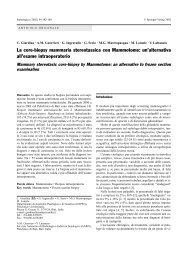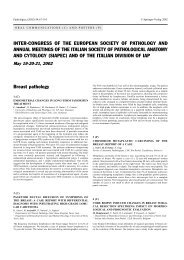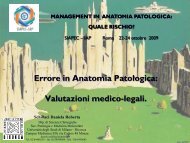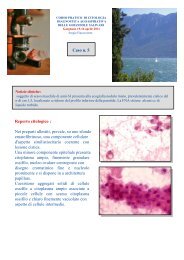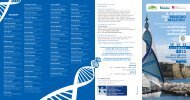Create successful ePaper yourself
Turn your PDF publications into a flip-book with our unique Google optimized e-Paper software.
PATOLOGIA DELLA MAMMELLA349cellule positive e l’intensità dell’immunomarcatura combinandoquesti dati in un sistema di “scoring”.RisultatiLa DMP-1 ha mostrato maggior espressione nei tumori didiametro inferiore (T1) e nelle forme ben differenziate (G1)ed è risultata positiva nel 48% dei casi liberi da metastasi, nel32% di quelli con sole metastasi viscerali e nel 19% dei casicon metastasi ossee e viscerali mostrando, pertanto, una correlazioneinversa con il rischio di metastasi ossee. Le curvedi sopravvivenza mostrano profili più favorevoli per i casiche esprimono alti livelli di DMP-1 e di BSP o alti livelli diDMP-1 e bassi livelli di BSP.ConclusioniI risultati suggeriscono che la DMP-1 può essere consideratacome un fattore prognostico protettivo rispetto alla comparsadi metastasi ossee in apparente antagonismo con la BSP.Quest’ultimo aspetto è avvalorato dalla possibilità di otteneredifferenti categorie di rischio e di sopravvivenza combinandole espressioni della DMP-1 con quelle della BSP. Seconfermati su casistiche più ampie questi dati potrebberoportare a possibili sviluppi terapeutici volti a interferire conle proprietà osteomimetiche delle cellule neoplastiche.hyperplasia and 10 fibroadenomas) were collected at the“Istituto Nazionale dei Tumori di Napoli”, Naples, Italy. Thecriteria for inclusion in the study were the availability of routinelyprocessed paraffin blocks for immunohistochemistryand adequate clinical information. The immunohistochemicalanalysis was performed using antibodies raised versus theN-terminal region of the HMGA1 proteins.ConclusionsHere we analyzed the HMGA1 expression in benign and malignantneoplastic diseases of the breast. No HMGA1 significantexpression was observed in normal breast tissue, whereasa strong positive staining was observed in breast carcinomasand in some benign breast diseases. Interestingly, the HMGA1expression is not present in 19 of the 45 ductal carcinomasanalyzed and at odds with data published in the human malignantneoplasias, the level of the HMGA1 expression in thepositive breast samples do not correlate with the tumor grading,whereas a positive correlation was found between HM-GA1 expression levels and c-erb-B2 amplification.References1Johnson KR, et al. Mol Cell Biol 1989;9:2114-2123.2Chiappetta G, et al. Int J of Cancer 2001;2:147-151.HMGA1 protein expression in human breastcarcinomas: correlation with C-ERB2expressionG. Chiappetta * , M. Monaco * , R. Pasquinelli * , G. D’Aiuto * ,G. Botti * , M. Di Bonito * , E. Vuttariello * , V. Giancotti *** , A.Fusco ***Istituto Nazionale dei Tumori di Napoli, Fondazione SenatorePascale, Napoli; ** Department of Biologia e PatologiaCellulare e Molecolare Facoltà di Medicina e Chirurgia diNapoli, Università di Napoli Federico II; *** Department ofBiochimica, Biofisica e Chimica delle Macromolecole, Universitàdi TriesteIntroductionBreast neoplastic diseases comprise a broad spectrum of diseasesranging from benign fibroadenoma to the very aggressiveundifferentiated carcinoma that it is lethal in a fewmonths. Even though the knowledge of the molecular eventunderlying the generation of human breast carcinomas has madeenormous progress, other information are required. At themoment some prognostic indicator are commonly evaluated.Among them c-Erb-B 2 overexpression and loss of estrogenreceptors correlates with a poor prognosis. Moreover, informationabout genetic alterations occurring in breast carcinomasmay suggest other therapeutic approaches. The HMGA familyis represented by three members: HMGA1a, HMGA1band HMGA2, being the first two proteins encoded by the samegene, i.e. HMG1a, through alternative splicing while HMGA2is coded for by a distinct gene 1 . Our group has previouslyshown that HMGA protein detection has a prognostic factor incolon carcinogenesis 2 , and that it can allow discriminationbetween adenomas and thyroid carcinomas. We have also demonstratedan abundant HMGA expression in several carcinomacell lines, and that the block of their synthesis through theinfection with an adenovirus carrying HMGA1 antisense sequencessuppressed their growth.Material and methods50 breast carcinomas (including 35 ductal carcinomas, 5 lobularcarcinomas, 10 in situ carcinomas) and 38 benign breastdiseases (including 13 thypical hyperplasia, 15 athypicalMammaglobin expression in breast cancertissues: correlation with prognostic factorsS. Roncella * , P. Ferro * , B. Bacigalupo * , D. Gianquinto ** ,F. Pensa *** , E. Falco ** , V. Ansaldo ** , P. Dessanti * , M. Moroni* , P. Pronzato *** , F. Fais **** , F. Fedeli **U.O. di Anatomia ed Istologia Patologica, di Oncologia *** ,di Chirurgia ** , Ospedale S. Andrea, La Spezia, Sez. di AnatomiaUmana, Di.Me.S., Università di Genova****IntroductionHuman Mammaglobin (hMAM) has recently been recognizedas a breast associated glycoprotein. Several studies haveproposed hMAM as a marker for molecular detection ofbreast cancer (BC) cells in blood, lymph nodes, bone morrowand malignant effusions.Although the biological role of hMAM is unknown, it hasbeen previously reported that hMAM gene expression is amarker of low biological and clinical aggressiveness of BC.In this study expression of hMAM mRNA in BC tissues hasbeen correlated with clinically pathological features in orderto evaluate the possible prognostic value of this marker.Methods148 cases of BC tissues were investigated for hMAM mRNAexpression by mean of reverse transcriptase polymerasechain reaction (RT-PCR).HMAM was correlated with age of patients, type and size oftumour, nodal stage, histologic grade (G), c-erbB-2 over expression,Ki-67 labelling index, ER and PGR status.Fisher’s exact test was used to examine the associationbetween different parameters and hMAM.ResultshMAM was expressed in 138/148 (93%) of BC tissues studied.Among the 10 hMAM-ve cases, 8 were invasive ductal carcinoma(G3 grade) and 2 infiltrating lobular carcinomas.Lack of hMAM mRNA correlated significantly with the G3histologic grade (P=0.01, Fisher’s exact test). In contrast, norelation was observed with age, tumour size, histologic type,nodal invasion or ER, PGR, c-erbB-2 and Mib-1 expression.





